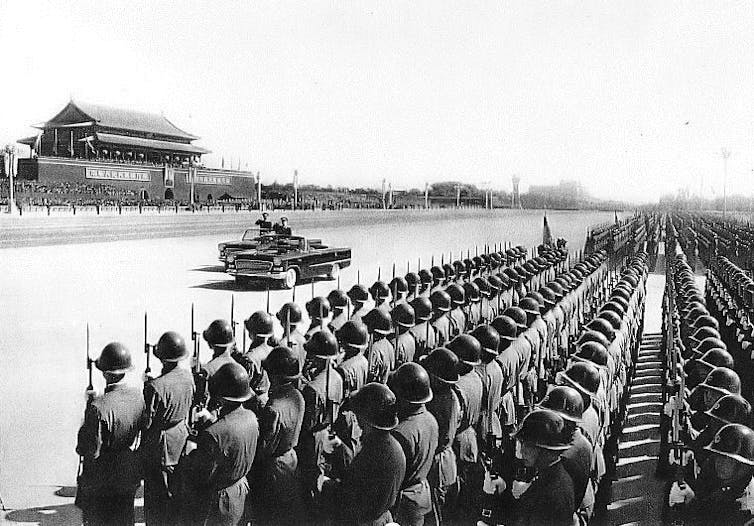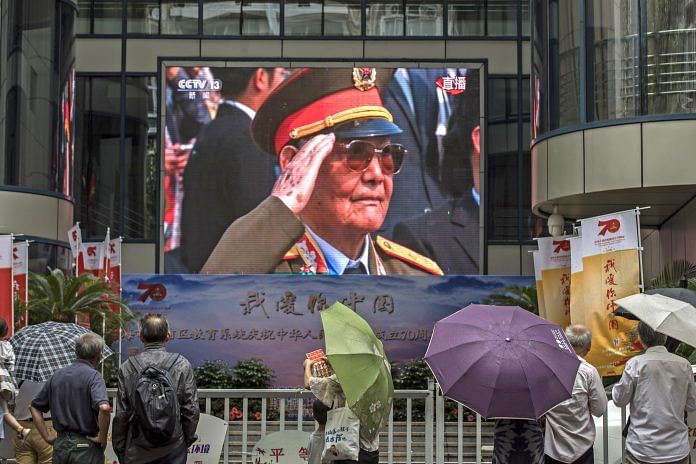Traditionally in China, 70 is an auspicious number. A person who reaches 70 is considered “rare and precious” (guxi 古稀) and the 70th birthday is worth a big celebration. To mark its own 70th anniversary on October 1, the People’s Republic of China (PRC) will hold a mass parade in Tiananmen Square in Beijing.
For the Chinese Communist Party (CCP), which has ruled such a vast country for 70 years and turned what was once viewed as the “sick man of Asia” into a major world power and the world’s second-biggest economy, this is a rare and precious occasion worth celebrating in a grandiose way.
The history of parades to mark China’s National Day can help to track the changing concerns and priorities of the country’s leadership over the past 70 years. Over time, such mega events have helped to validate the political status and legitimacy of the CCP leadership, and connect the distant, autocratic state with ordinary people through spectacle.
After the founding of the PRC in 1949, one of the major tasks of the new People’s Government was national, cultural and educational work, which meant raising the cultural level of the masses. It sent delegations to the USSR to learn how to stage “socialist-style” national events. In the early years of the PRC, the state staged two annual mass parades, one on May Day and the other on the national day on October 1, whose design closely resembled Soviet parades. They were displays of the CCP’s military force, core economic goals and achievements as well as occasions for the masses to show devotion to the party and state.

The 1959 National Day parade celebrating the tenth anniversary of the PRC’s foundation was the biggest yet. In anticipation for the event, the newly constructed square in front of the Tiananmen, the gate of the former imperial palace of Beijing’s Forbidden City, was enlarged. It would surpass the size of the Red Square in Moscow and become the biggest square in the world, with space for a million people. This was viewed as a tangible way to display the CCP’s “Great Leap Forward” to the world.
But in the aftermath of the 10th anniversary jubilation, China leaped into great chaos. Mao Zedong’s utopian vision to take the country into a communist paradise ended with the worst famine and environmental disaster in history, which claimed tens and millions of lives as well as killing many animals and plants.
Frugality and revolt
In response to the “catastrophic natural disasters” – to use the official euphemistic formulation at the time – in September 1960, the CCP leadership made a strategic change to the protocols governing National Day celebrations. An official decision declared that from then on:
National Day will be celebrated with frugality: there will be small-scale festivities every five years (xiaoqing 小庆) and major celebrations (daqing 大庆), including a military parade, only every ten years.
A march past would continue to feature every year on October 1, but between 1960 and 1984, no military review was held. This was partly due to the disruption of the Great Proletarian, or Cultural Revolution.
After Mao’s death in 1976, under the leadership of Deng Xiaoping, the CCP passed a new protocol to resume the military reviews on October 1. The next parade was held in 1984 to celebrate the 35th anniversary of the PRC, alongside China’s achievements brought about by the post-Mao economic reform under Deng’s leadership. But the memory of this celebration was short-lived.
In 1989, a few months before the 40th anniversary national celebration, hundreds and thousands of workers, students and ordinary residents took to Tiananmen Square in Beijing to raise grievances against official corruption and increasing inequalities, and to press for greater freedom. Their peaceful demonstration was brutally suppressed by the communist authorities. The image of tanks rolling down Tiananmen Square changed the global meaning of the square from a political space designed to celebrate the successes of the Chinese communist revolution and national unity, to a space of resistance to authoritarian rule and oppress.
In the aftermath, there were no mass gathering or mega events held on Tiananmen Square for the next decade. Then in 1999, under Jiang Zheming’s leadership, the CCP Central Committee decided to hold a National Day parade in the square to mark the PRC’s 50th anniversary. The event would showcase the PRC’s economic and technological achievements in the post-Mao era as well as celebrate Hong Kong and Macao’s recent return to the Chinese motherland.
Opening the door
While the 1999 National Day parade was similar in style to previous parades, it showed the changing political priorities of the CCP leadership as China moved towards the 21st century. Slogans included: “Open door, and reform science and education to build the nation, rush to the next century!”, “One country two systems, reunite the motherland, peaceful development!” and “Political stability, economic development, cultural blossoming, social progress”.
Despite the Ministry of Defence’s promise to put on a “frugal and cost-effective” show for the 60th anniversary in 2009, it was, until now, the most spectacular display of the PRC’s military might. On show were 56 phalanxes of more than 10,000 People’s Liberation Army soldiers, 500 tanks and military vehicles and 151 combat aircraft. In military terms, 90% of the armaments, which included nuclear-capable intercontinental missiles, were shown to the public for the first time.
Social, cultural and technical feats were celebrated on floats following the military display. These included symbols of national achievements from the space programme to the bullet train, hybrid rice and family planning. There were also symbols of national unity, including floats representing 56 national minorities. Traditional power symbols and cultural icons once condemned as feudal – such as the dragon, the philosopher Confucius and some religious symbols like the lotus flower – were also on display for the first time since the founding of the PRC. By reclaiming “Chinese traditions”, the CCP hoped to generate positive feelings about its rule.
Focus on the people
Ahead of the 2019 parade, the CCP is anxious. Alongside continued unrest in Hong Kong and tensions with Taiwan, China’s economy is flagging, the wealth gap growing and health scandals increasing. Fewer and fewer people in China trust the current leadership.
To ensure its 70th celebration turns out a “joyous, happy and harmonious” occasion, the state media has focused on efforts by the the CCP to eradicate poverty, improve people’s livelihood and health, as well as reiteration by China’s leaders of the old Chinese saying that “the people are the foundation of the state”.
But while the dissemination of large televised parades into living rooms and onto mobile phones across China is a key way in which ordinary Chinese people experience the state’s central programmes, it also unveils China to a global audience.
“The foreigners are looking” has been a constant anxiety of modern Chinese elites. The success of the National Day parade is therefore important to promote the idea among the leadership that: “We, the CCP leadership have won international respect for China.”
Like the opening ceremony for the 2008 Beijing Olympics, held under the motto “one world, one dream”, the 70th anniversary will allow the CCP to promote China as a harmonious, peaceful and benign world power. Expect the parade to present China as major player in the international order on all key environmental issues including climate change and the need for sustainable use of resources.![]()
Xun Zhou, Reader, Department of History, University of Essex
This article is republished from The Conversation under a Creative Commons license. Read the original article.



